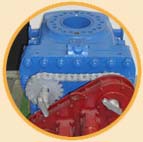Stages of
Drilling
 Wells are
normally drilled in stages, starting with a surface hole drilled to reach a
depth anywhere from 60 to 400 metres, depending on final well depth and area
conditions. The crew then pulls out the drill string and inserts steel pipe,
called surface casing, which is cemented in place, to keep the wall from caving
in. It controls the return flow of mud and other fluids encountered during
drilling and also prevents contamination of groundwater. The beginning of the
actual drilling, which takes place after the surface hole is drilled, is called
spudding in. Wells are
normally drilled in stages, starting with a surface hole drilled to reach a
depth anywhere from 60 to 400 metres, depending on final well depth and area
conditions. The crew then pulls out the drill string and inserts steel pipe,
called surface casing, which is cemented in place, to keep the wall from caving
in. It controls the return flow of mud and other fluids encountered during
drilling and also prevents contamination of groundwater. The beginning of the
actual drilling, which takes place after the surface hole is drilled, is called
spudding in.
After setting
surface casing and installing the blowout preventers (BOPs), the crew resumes
drilling. A probe for shallow gas or heavy oil in eastern Alberta or
Saskatchewan may require only two or three days to drill 450 metres through soft
shales and sandstone to the target depth. However, a rig may work eight months
or longer to penetrate 4,500 metres or more through hard, complex rocks in the
foothills of the Rockies.
When the bit
needs to be replaced because of wear or changing rock strata, the crew has to
pull out the entire string, unscrewing sections of pipe in single, double or
triple sections, depending on the height of the derrick, and stacking them
upright in the derrick. Then they have to put the whole string back into the
hole again, with the new bit in place. This process, which can be very laborious
and time-consuming for a deep hole, is called tripping. Major improvements in
the durability of bits and the formulation of drilling fluids since the 1980s
have greatly reduced the number of trips required to drill a well. Many shallow
wells today are drilled without a bit change.
If the string
breaks or gets stuck in the hole, a specialist is called in to help the crew go
fishing with special tools. No one wants to lose an expensive bit and
bottom-hole assembly, but the blocked hole is the real problem. As a last
resort, the crew drills a curved section called a sidetrack to bypass the
debris.
Petroleum Communication Foundation. Our Petroleum Challenge: Exploring Canada's Oil and Gas Industry, Sixth Edition. Calgary: Petroleum Communication Foundation, 1999. With permission from the Centre for Energy.

|
|
 Heritage Community Foundation Presents
Heritage Community Foundation Presents





